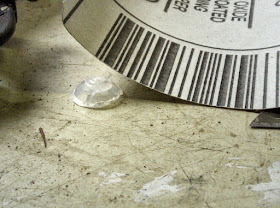Since putting the camera into "super macro" prevents using RAW, I thought I'd do the other method and just apply "digital zoom" (which does not preclude RAW) and have a look at what it does.
For clarity, setting RAW records two files of the same name, one with extension .jpg the other .dng each time you take an image.
So I took this image, and zoomed in (with the volume buttons, to I think about x3):
Does that red patch stand out to you? Mate, that's ham fisted stuff if you ask me allowing saturations of channels to do that. However when I look at the DNG that it wrote, I see this:
no red patch ... and which is what was visible on my screen before I had done any "digital zooming". Given that by definition a RAW file captures only what the sensor captures, and that this is what I saw before "digital zooming" it strongly suggests that this is exactly what is happening on "super macro" .. just digital zoom on close focus.
So as I said in the earlier post camera is doing cropping and upscaling (because it still writes 4160 x 3120 Pixels) in software.
Does this bring losses?
Yes, but it would be splitting hairs and only pixel peepers will be worried. It does suggest though that the "super macro" is redundant.The long answer is found looking at the DNG that was saved and comparing it to the JPG created.Will it work out in the "wash"?? To answer that lets look at both clearly we need to:
- crop and upscale the DNG
- examine the JPG (which has already been processed in "camera")
So, first up, a pixel peep at the JPG. This is a screen grab of using Irfanview on my PC to examine the JPG
this is (if you click on the image and look in the lower left corner about 50% view, but there is clearly no point in zooming in anymore as the bit of plastic there is already losing details.
Ok, now, this next image is the result from the DNG. To get this:
- I used dcraw to conver it to a TIFF and then
- loaded it into Photoshop to get the colours to match closely that of the JPG, then
- used NIK (free google software) to reduce the colour noise, then
- cropping the guts out of the middle of the DNG then
- doing a bicubic upscale in Photoshop (200%) then
- resaved that TIFF.
lots more work right?
Was it worth it?
I think that it shows a bit more detail than the JPG. You can see more detail in the bit of plastic, and also the inkjet marks on the bar code of that bit of sand paper.
But by all accounts the JPG is an excellent result when you factor in not doing much to get it!
Either process is good, but if you weren't zooming then (as mentioned in another post) DNG is the best results from this camera : hands down.
But the results of digital zoom is a hell of a lot better than what you'll get if you just crop the JPG (without digital zooming) to get this same view. Looking at that at 100%:
It is much smaller and looks quite awful (sorry, added the paper for greater visual information later so they are not the exact same picture).
I encourage you to open that image file in a new tab or window and observe how much smaller it is ... its 608 x 339 Pixels. So this won't even look good on an MMS...
So I think this validates what I wrote in my earlier exploration of the Super Macro:
- the camera is doing an upscale followed by a crop of the sensor capture
- writing out a JPG (which gets smudged up by its crummy attempts at noise reduction)
- but makes a very good file for your macro shot
If you happen to be inclined to edit on the phone (say using "Photo Editor") then I'd say don't shoot and crop, because the JPG's are so crummy. Digital Zoom will look much better and all you will have to do is downsize (which MMS does for you).
and no, I just cropped and didn't do any upscales ... this was my first play with Snapseed and I must say I'm impressed. I ended up making this conversion pretty gritty.
curve ball
I downloaded Snapseed which is a on phone RAW development tool. I think it did a pretty good job, take a look:and no, I just cropped and didn't do any upscales ... this was my first play with Snapseed and I must say I'm impressed. I ended up making this conversion pretty gritty.
so, in my view...
I reckon that what this says is that:
- if you want the best shot from this camera, use RAW and be prepared to process it
- if you are inclined to use digital zoom, then do it, as with the way this camera / phone software processing works you'll have the most bang for the effort buck
- for macro use Super Macro
- for almost everything you do (especially if you're going to text the image), if you were intending to "crop tighter" then zoom before capture, because for no effort on your part it'll do 90% of the job
- if you really want to squeeze every bit out of this image making tool, then use RAW (and be prepared for some work)
I don't know where the turn around point on this process is for diminishing returns, but as the above was x3 and there is more room to move, then I think even x4 digital zoom will work quite well enough.
Happy Shooting






The cropped JPG looks better to me in my browser.
ReplyDelete